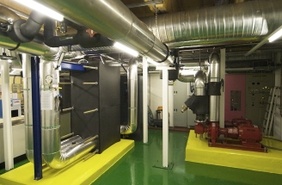 There are more than 81 billion square feet of commercial floor space in the U.S. today. And the energy use of all commercial buildings in the U.S. accounts for 36% of the more than $190 billion we spend on energy every year. So it stands to reason that if we can increase the energy efficiency of our commercial buildings, we can significantly decrease our annual energy expenditures.
There are more than 81 billion square feet of commercial floor space in the U.S. today. And the energy use of all commercial buildings in the U.S. accounts for 36% of the more than $190 billion we spend on energy every year. So it stands to reason that if we can increase the energy efficiency of our commercial buildings, we can significantly decrease our annual energy expenditures.
Retro commissioning is one of the most cost effective means for improving energy efficiency in commercial buildings. The Lawrence Berkeley National Laboratory (LBNL) conducted a study to evaluate the cost effectiveness of retro commissioning on over 30 million square feet of building space. Their findings indicated a median energy savings of 15 percent and a simple payback of 0.7 years.
So what is retro commissioning? It is a set of systematic procedures for reviewing an existing building in order to return or keep the facility operating according to the owner’s project requirements. It typically focuses on the building’s energy-using equipment such as HVAC and lighting equipment and controls. Retro commissioning identifies improvements to building controls and other low cost operational measures. In addition to the energy saving deficiencies it uncovers, retro commissioning also has many non-energy benefits such as improved occupant comfort and productivity, better indoor air quality, and extended equipment life.
Taking the First Steps
There are many variations and definitions of retro commissioning. It is important for building owners and operators to understand exactly what services the retro commissioning agent is going to perform for them. Qualified retro commissioning agents with an in depth knowledge of MEP/FP systems design, installation, operation and maintenance can guide building management to make cost effect decisions on what energy saving measures to pursue.
Often overlooked in contracting for retro commissioning services is that the process usually identifies small repairs and programming changes that are necessary to improve performance. Examples include reattachment of damper linkages, setting up time-of-day schedules, and replacement of faulty sensors. The value of the repairs is typically a small percentage of the overall retro commissioning effort, but most building owners prefer to have a single contract for entire process. Since it’s difficult to quantify repairs before the process begins, an allowance for repairs and adjustments can be included in the base contract. Alternately, the owner may engage its on-site maintenance contractors to effect these repairs, but whichever direction is chosen, it should be discussed as early as possible in the process to maximize energy-saving benefits and avoid unpleasant surprises.
Continuous Commissioning
To be truly successful, retro commissioning should not end at project closeout. Facility staff needs training on the energy improvements implemented. They need to understand their role in the continual pursuit of energy savings and improved operations. In many cases, the retro commissioning process can provide the means to collect, analyze, and evaluate key performance indicators so that building operators can quickly learn when the building is not operating properly and take corrective actions. This allows owners to break free from the cycle of tune-up and degradation and ensure their buildings are operating properly on a continuous basis.
Additional Resources:
http://cx.lbl.gov/2009-assessment.html
http://www.energystar.gov/buildings/tools-and-resources/energy-star-building-upgrade-manual-chapter-5-retrocommissioning

